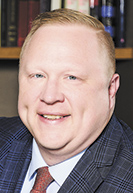Subscriber Benefit
As a subscriber you can listen to articles at work, in the car, or while you work out. Subscribe NowTwo years after undertaking specific steps to improve Hoosiers’ civic engagement, the Indiana Bar Foundation and its partners are celebrating advancements in the education arena but are also continuing to find challenges in getting voters to the polls.
The assessment is part of the 2021 Indiana Civic Health Index, which was released at a press conference Jan. 25. Along with providing an update on the state’s civic condition, the report also included an analysis of the data that had been collected since the first of the five indices was released in 2011.
“The data can and should give us some pause to reflect and continue to advocate for Indiana civic health, but there are reasons to celebrate,” said Ellen Szarleta, primary author of the index and director of the Center for Urban and Regional Excellence at Indiana University Northwest.
Szarleta highlighted Hoosiers’ social and community connectedness as well as donations to charitable and religious organizations. Since 2010, the volunteering rate in Indiana has increased from 26.1% to 34%, moving the state’s national rank from 32 to 18. Also, 50.6% of the state’s residents made a donation in 2020 compared to 45.6% in 2010. This uptick improved Indiana’s national ranking for donations from 45 to 33.
“So we see some of these indicators definitely showing promise for us and also informing us what it is that Hoosiers prefer to do when it comes to the forms of civic engagement that are so vital to us,” she said.
With the release of the 2019 Indiana Civic Health Index, the authors made two recommendations: improve civic education and increase voter turnout, with the goal of moving Indiana from the bottom 10 states to the top 10 in participation.

As Charles Dunlap, president and CEO of the Indiana Bar Foundation pointed out, the two goals are linked.
“We have found that in a lot of our efforts with civic education, outreach and (being) focused on the education part of it, that it leads to greater participation in voting and many other things,” Dunlap said. “If you want to have more participation, there’s an educational component and an outreach component, and you really need to do both.”
In the classroom
Led by the bar foundation, the work on bolstering civic education in Indiana schools has been gaining momentum and has accelerated past the original timeline for achieving certain goals.
A civic education task force, chaired by Indiana Lt. Gov. Suzanne Crouch, released its report in November 2020 outlining how civics education programs could be improved in Indiana classrooms. The Indiana General Assembly then passed House Enrolled Act 1384 during the 2021 session, which requires a semester-long course in civics be included in middle school curriculum.
“We’re extremely pleased with the overall progress we’ve seen in advancing civic education over the past two years since the last civic health index in 2019,” Dunlap said.
Now the Indiana Civic Education Commission, created by HEA 1384, is getting ready to begin its work. By statute, the commission has been charged with reviewing the pedagogy and policy for civics education as well as making recommendations for the new civics curriculum. In addition, the Indiana Department of Education is expected to soon release the standards for the middle school civics course.
Dunlap said the bar foundation is turning its attention to helping teachers. He noted that in a survey taken by the task force, educators said they did not have the time in the school day, nor did they feel they had the expertise, to teach civics.
“The Indiana Bar Foundation and others, we want to help teachers and schools around the state who all of the sudden now have a semester-long course in civics that they need to teach in middle school,” Dunlap said. “We want to help give resources to teachers and do additional things to help them with that course obligation.”
Introduction of the new civics curriculum is coming at a time when increased scrutiny is being given to the courses and ideas that are taught in Indiana classrooms. However, Dunlap said he does not see any trouble because, he said, civic education is a nonpartisan issue, as shown by the near unanimous support for HEA 1384.
“There will be controversial issues in civic life and in our daily life, and that’s expected,” he said. “How we deal with it, how we discuss it, needs to be civil and constructive. Those are the kinds of things really that good quality civic education brings into its delivery.”
At the voting booth
The effort to increase voter turnout in Indiana, which was led by the Indiana Citizen Education Foundation, demonstrated success will be harder to obtain.

Bill Moreau, co-founder and president of the foundation and former partner at Barnes & Thornburg LLP, walked through a detailed analysis of Hoosier participation in the 2020 presidential election. Although 61% of Indiana voters cast a ballot in the 2020 presidential election, nearly 3 percentage points higher than 2016, the Hoosier State still lagged behind the national average, which jumped to 67%.
As a consequence, rather than jumping from the bottom 10 states in voter turnout to the top 10 states, Indiana actually dropped five spots from 41st in 2016 to 46th in 2020.
“Sadly the numbers show we have a very, very long way to go before we as a state capture our place among the top 10,” Moreau said.
For much of the last century, from 1924 to 1979, Hoosiers consistently logged some of the highest voting rates in the country, according to data cited by Moreau. The civic health index linked Indiana’s dramatic fall in participation to the absence of contested elections and what are described as restrictive voting laws.
Redistricted maps have fostered uncompetitive races where outcomes have been predetermined to favor one party, the index stated. This, in turn, has fueled the belief among nonvoting Hoosiers that their votes do not matter.
Depressing the vote even further are Indiana’s voting laws, which are seen as creating barriers to casting a ballot. The index examined the seven states that regularly record some of the highest voter turnout in the country and found, unlike Indiana, those seven allowed same-day voter registration, unrestricted absentee voting, kept the polling places open more than 12 hours on election day and required that employers give workers time off to vote.
“Indiana is consistently ranked among the states with the most restrictive voting laws,” Moreau said. “This begs the question, should the legislation affecting the conduct of Indiana elections be analyzed through the prism of whether the bill encourages or discourages additional turnout?”
A key to increasing turnout, Moreau continued, is to get Hoosiers registered to vote. Pointing to the 2020 election, Moreau maintained once people are on the voting rolls, they will take the next step and vote.
Also, he dismissed the notion that the push to get more voters registered was being done at the expense of educating voters about the issues.
Calling it a “false choice,” Moreau said, “We know that study after study after study shows when Americans take that first step to get registered, they actually do then have an incentive to get informed … .”
Partnering with the bar foundation and Indiana Citizen on the civic health index are Indiana University Northwest, the Center for Representative Government at Indiana University, the Indiana Supreme Court, Indiana University-Purdue University Indianapolis, the O’Neill School of Public and Environmental Affairs and the National Conference on Citizenship.•
Please enable JavaScript to view this content.
